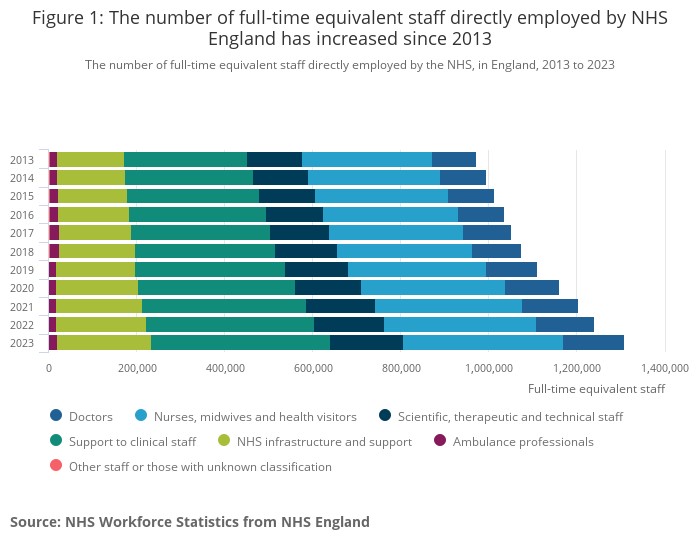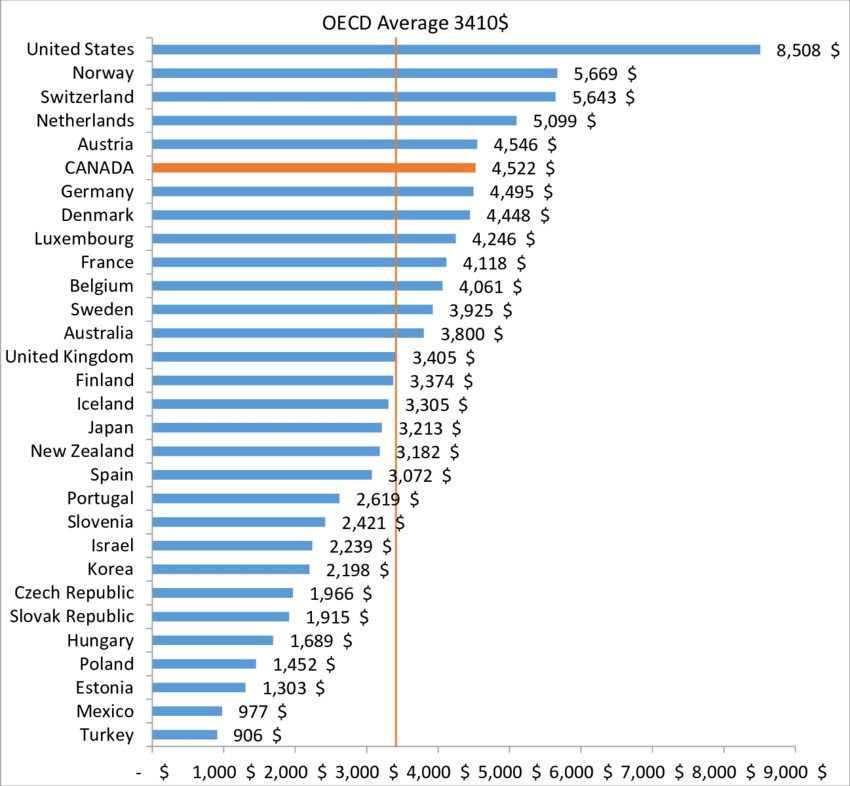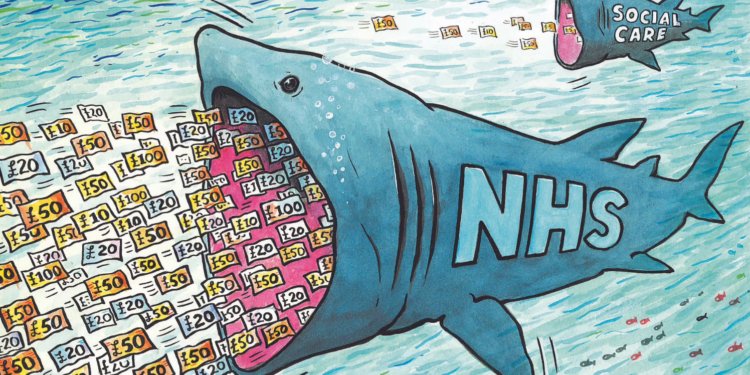It used to be that our beloved NHS was in crisis every winter. But now the NHS seems to be permanently in crisis. And every year we’re told the NHS needs ever more of our money and ever more staff. In this week’s budget it was handed another few billion which will no doubt disappear down the massive toilet of waste and profligacy that is our national healthcare service.
I realise we have had the pandemic and then seemingly endless strikes by doctors and others. But the NHS’s problems started long before the pandemic and the strikes.
Last week the Office for National Statistics (ONS) released data showing the number of staff by main work categories for each of the constituent parts of the U.K. – England, Scotland, Wales and Northern Ireland. (These figures are expressed as FTEs – full-time equivalents – so this takes account of people who may be working part-time.)
As each of the countries classes NHS employees in slightly different ways, it’s difficult to get reliable total NHS employee figures for the whole U.K. However, if we just look at the largest part of the NHS – NHS England – we can get a reasonable idea of what’s going on. Here’s a summary chart produced by the ONS:

Now let’s look at the numbers:
- The number of doctors increased by 37,467 (up 37%) from 101,137 in 2013 to 138,604 by 2023.
- The number of nurses and midwives increased by 68,063 (up 23%) from 295,163 in 2013 to 363,226 in 2023.
- The number of scientific staff increased by 42,938 (up 13%) from 123,912 in 2013 to 166,850 in 2023.
- The number of support staff increased by 125,510 (up 45%) from 279,579 in 2013 to 405,089 in 2023.
- The number of infrastructure staff increased by 62,758 (up 41%) from 152,437 in 2013 to 215,195 in 2023.
- The number of ambulance staff increased by just 1,721 (up 10%) from 17,537 in 2013 to 19,258 in 2023.
Here are just a few things you might have noticed:
- The total number of staff increased by 338,4577 (35%) from 969,765 in 2013 to 1,308,222 in 2023.
- The largest increases were in non-medical staff, with support staff shooting up by 45% and infrastructure staff rising by 41%.
- The smallest increase was in ambulance staff – up just 10%. Some people might find that slightly worrying. But don’t worry, at the same time as the number of ambulance staff has gone up by only 1,721, the number of DIE (diversity, inclusion and equality) managers has shot up from virtually none in 2013 to more than 800 now. So, if an ambulance does actually manage to reach you before you croak it, the ambulance workers will no doubt be wonderfully racially and gender diverse, which is what you absolutely want from an ambulance service.
We’re constantly told that one reason the NHS is collapsing is a rising population. But the population of England only rose by around 7% between 2013 and 2023. At the same time the number of doctors rose by 37% and the number of nurses and midwives rose by 23%. In Scotland the number of NHS staff rose by about 20% while the population only rose by around 2.7%. In Wales NHS staff numbers increased by 32% while the population only went up by 2%. And in Northern Ireland, NHS staff numbers rose by 20% while the population only increased by 4%. So the excuse of the NHS needing many more staff to cope with a rapidly rising population doesn’t hold water.
Another reason given for the NHS’s constant state of disintegration is that the U.K. population is getting older. Over the period from 2013 to 2023 the mean age of the U.K.’s population rose from 39 years to about 41.5 years – a rise of 6.4%. So this excuse seems pretty flimsy, too.
And then there’s the usual bleating that we don’t spend as much on health as other developed countries. It’s true that we spend less per capita than several European countries. But U.K. health spending per capita is on the OECD average:

While there is some truth in the claim that some other countries spend much more per capita on health, many spend less and we don’t hear about their health systems collapsing like our beloved NHS. So levels of spending and staffing cannot be the only reasons for the utter chaos in our health service.
A better explanation for the NHS’s floundering failure can possibly be seen in the massive increase in non-medical staff – an increase in support staff in the NHS England of an astonishing 45% and in infrastructure staff of 41%. It’s not obvious why a population which has increased by just 7% between 2013 and 2023 and which has got very slightly older should require such a huge rise in non-medical NHS staff. And there has been a 22% increase in NHS administrative staff in Scotland, Wales and Northern Ireland yet the population served by the NHS there has only gone up by around 2.7%.
But you can look at the numbers, think about your own, your friends’ and your families’ experiences of our pitiful NHS and make up your own minds about the competence of NHS management and the fact that our NHS seems to be doing ever less with ever more money and ever more staff.
David Craig is the author of There is No Climate Crisis, available as an e-book or paperback from Amazon.











To join in with the discussion please make a donation to The Daily Sceptic.
Profanity and abuse will be removed and may lead to a permanent ban.
No British government, as we head into totalitarianism, is ever going to get rid of the state propaganda service.
https://www.theguardian.com/media/article/2024/jul/12/keir-starmer-commits-to-keeping-bbc-licence-fee-after-years-of-tory-hostility
Doctors Want Covid Jab Suspension – latest leaflet to print at home and deliver to neighbours or forward to politicians, your new MP, your local vicar, online media and friends online. We have over 200 leaflet ideas on the link on the leaflet.
Looks like Dr Malcolm Kendrick mostly won his case against the Daily Mail over statins-
https://drmalcolmkendrick.org/2024/07/11/a-little-more-on-the-trial/
Well cardiovascular disease has always been with us, I suppose, and has various causes, but it would seem demand for cardiac care is outstripping supply. So with regards to this record high number of people awaiting treatment, I’m baffled;
”Brits are being warned to look out for symptoms of a deadly disease, as the number of people awaiting heart care in England rose to a record high. The latest NHS figures show cardiac waiting lists rose to 421,433 at the end of May 2024.
This is an increase of 2,394 on the month before and the highest total on record. Since May 2022, the heart care waiting list in England has grown by nearly 100,000 people when the waiting list was at 327,258 – an increase of 29 percent.
This has been branded “frightening” by the British Heart Foundation (BHF), which is calling for the Government to prioritise cardiovascular disease treatment. Dr Sonya Babu-Narayan, BHF associate medical director and consultant cardiologist, said: “I find it frightening that long waits for time-critical heart care are putting people at risk of life-long disabling heart failure or death.
“That’s why it’s so disheartening to see the latest figures continue to show the worst access to vital, timely heart care in living memory. We cannot and must not get used to these unacceptable figures showing too many heart patients waiting too long.
“Getting to grips with this cardiovascular disease crisis and getting back to gold standard heart disease prevention, early diagnosis and treatment must be a priority for our new Government if they want to avert yet more avoidable heartbreak and loss of life.”
https://www.gloucestershirelive.co.uk/news/health/heart-disease-10-symptoms-9407051
The BHF are a fake charidee. It wholly supported the Scamdemic, masks, lockdowns, the works. An absolute bloody disgrace.
I saw a vid clip of Dr Malhotra admitting that he is also ”vaccine injured” the other day. That’s all he said on the matter, but he may have elaborated further in a different part of the interview, I didn’t watch the full thing. Because of his profession, and how he works in the private sector now, he could’ve ran various tests on himself in order to find any abnormalities, or perhaps he presented with clinical symptoms, not sure which. Maybe someone else on here has more deets…But going by various studies that’ve been done now, there’s an awful lot of people wandering around with subclinical heart damage and they’re completely unaware. So does this essentially make them ticking time-bombs, and we’re seeing the results of the mass jabathon experiment in the stories we read and the increase in stats, such as the ones mentioned above, and the excess deaths, of course? Then there’s the cancers that’ve increased, etc. The trend seems to be getting worse not better. But I think all of this has been obvious to we on here for a long while now. Props to Dr M for confiding this information about himself though, and continuing his fight to expose the serious damages done to us in the name of ( laughably ) ‘public health’.
Thanks Mogs
“calling for the Government to prioritise cardiovascular disease treatment”
Of course they are as that will provide greater research funding opportunities for the BHF.
Haha, see how the leftards kick off when you blaspheme against the Alphabet People cult.
But somebody ought to remind this awesome, truth-telling lady ( with the gorgeous hair. I’ll take this screenshot to my hairdresser ) that women’s secret weapon is that they were born hermaphrodite, thereby it is exclusively down to them if they produce babies or not. No requirement for the cooperation of a willing male whatsoever, therefore the decreasing birthrates are down to them and them only….Which is the ‘logic’ of the resident women-haters. Well, I think we all know you can’t reason with stupid, delusional people who are fueled by their innate bitterness by now.
”Slovakia’s minister for culture blamed the LGBT movement for Europe’s plummeting birth rates, arousing the ire of left-leaning ideologues.
During a July 3 interview with Slovak tabloid Topky.sk, Culture Minister Martina Šimkovičová blamed LGBT ideologies for Europe’s dropping fertility rates.
“We heterosexuals are creating the future because we make babies. Europe is dying out, babies are not being born, because of the excessive number of LGBTQ+ (people). And the strange thing is (that it’s happening) with the white race,” the minister said in comments cited by left-liberal news outlet Politico.
“We are living in an amoral era,” Šimkovičová elaborated.
In response to Šimkovičová’s July 3 comments, Peter Weisenbacher, director of the Bratislava-based Human Rights Institute, lodged a criminal complaint with the general prosecutor’s office against the minister, alleging that her remarks were racist and anti-Semitic.
In another interview, the minister admitted that “we are a sick society.”
In January, Šimkovičová revealed that the country’s culture ministry would cease financing LGBT projects.
“The LGBTI+ organizations (…) will no longer parasitize on the money from the culture department. I will certainly not allow it under my leadership,” Šimkovičová wrote on Facebook.
She added that she “rejects progressive normalization” and that her plans are for “a return to normality.”
Besides her anti-LGBT views, Šimkovičová has been noted for her tough stance on immigration, much to the chagrin of the globalist elites in the European Union (EU) and their ideological allies. To address the issue of Slovakia’s falling population, the EU elites have suggested bringing in migrants instead of encouraging Slovak families to have children.”
https://www.lifesitenews.com/news/slovak-culture-minister-triggers-leftists-by-blaming-lgbt-ideology-for-low-birth-rates/?utm_source=most_recent&utm_campaign=catholic
” No requirement for the cooperation of a willing male”
a ‘willy’ed male!
Agree about the hair, gorgeous
and agree with her veiws, not saying its the whole cause, but this celebration of non proliferation certainly doesn’t help the matter
Yeah she speaks as she finds, and speaks perfect truth, as far as I’m concerned. So if stating inconvenient facts ruffles the Leftards’ feathers and upsets their snowflake-like sensibilities then more power to her elbow. She’s over the target.
U.K. hasn’t allowed Ukraine to use Storm Shadow missiles inside Russia, MoD clarifies
Order, counter order, disorder. Welcome to your new government.
This one seems to be run by the Grand Old Duke of York. The only difference is that ten thousand men might be a bit of a stretch these days…….
What”s really going on?
Topical because, apparently, it’s not just Britain that is a bit short of troops.
The Russian military is redeploying wounded soldiers to frontline combat in the Kharkiv direction.
Social media images show soldiers from the 26th Tank Regiment, located northwest of Vovchansk, visibly injured, in casts, and on crutches, being sent to the front lines despite still undergoing medical treatment.
Remind me, who was the last ‘admired political operator’ who did this to his soldiers?
Oh yes, it was Saddam Hussein.
Whatever happened to him?
‘Nota bene’
Hussein was the Western governments kind of leader, then he wasn’t. Similar to Vladimir Putin but dealing with Putin in the same way isn’t so easy.
Zelensky is currently the Western governments kind of leader – ‘nota bene’.
“Half of Cabinet accused of house-building ‘hypocrisy”
And we’re do they stand on wind turbines?
Is Ed going to have a dozen of them around his house?
He’s declaring war on nimby’s let’s not forget!
I wouldn’t necessarily say it’s hypocrisy to represent the interests of the people whom you were elected to represent.
“How the White House hid the truth about Biden’s decline from the world”
They just denied it, they couldn’t hide it,
It was plain for anyone with eyes to see!
“James Cleverly leads race to replace Rishi Sunak, poll suggests”
James Cleverly? OMG! Is that the best they’ve got? Jumping jehoshaphat, Cleverly by name but certainly not by nature!
“It won’t be long before the Muslim Vote poses a real challenge to Labour”
It won’t be long before the Muslim Vote poses a real challenge to
LabourBritain!
I have been posting about this for some months now. Perhaps Frank Haviland has been reading DS.
Highly likely Hux
This presupposes that voting will produce a government representing the population rather than other interests. This seems contrary to reality no matter how many Atheists/Muslims/Jews/Christians/Hindus get elected.
However, it’s a good way to keep people in fear and distracted for 5 years in the lead-up to the all-important 2030.
“We will stand with people staring down the outrage mob” – A joint op ed in the Australian by the leaders of the four Free Speech Unions urges people to band together to defend the most important human right of all.”
Excellent! Please print out that statement by the Four Free Speech Unions somewhere on the Daily Sceptic, so that we can all read it (access to the Australian blocked).